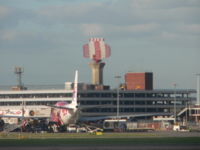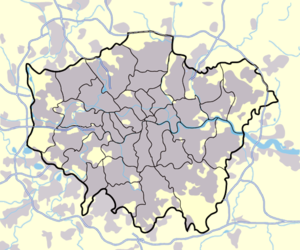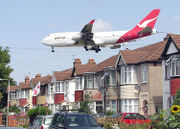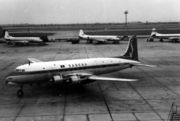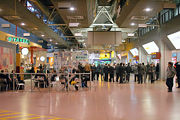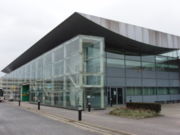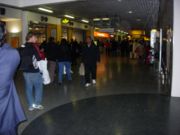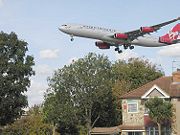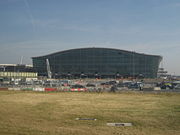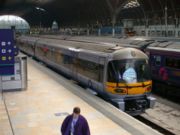London Heathrow Airport
2008/9 Schools Wikipedia Selection. Related subjects: Geography of Great Britain
| London Heathrow Airport |
|||
|---|---|---|---|
| IATA: LHR – ICAO: EGLL | |||
| Summary | |||
| Airport type | Public | ||
| Owner/Operator | BAA | ||
| Location | London | ||
| Elevation AMSL | 83 ft / 25 m | ||
| Coordinates | |||
| Website | |||
| Runways | |||
| Direction | Length | Surface | |
| m | ft | ||
| 09L/27R | 3,902 | 12,802 | Grooved Asphalt |
| 09R/27L | 3,658 | 12,001 | Grooved Asphalt |
| Statistics (2007) | |||
| Aircraft Movements | 481,476 | ||
| Passengers | 68,066,028 | ||
| Statistics from the UK CAA | |||
London Heathrow Airport or Heathrow ( IATA: LHR, ICAO: EGLL) is the principal airport for London, England. The United Kingdom's biggest airport, Heathrow is also Europe's busiest airport for passenger traffic, and handles more international passenger traffic than any other airport in the world. Heathrow is owned and operated by BAA, which also owns/operates six other UK airports and is itself owned by an international consortium led by the Spanish Ferrovial Group. Heathrow is the primary hub of British Airways and Virgin Atlantic and a major hub for bmi.
Located 15 miles (24 km) west of Central London, England, Heathrow has two parallel main runways running east-west and five terminals. Terminal 5 was officially opened by Queen Elizabeth II on the 14 March 2008 and opened to passengers on 27 March 2008. Construction of Heathrow East to replace Terminal 2 and The Queens Building is planned to start in 2008 and be completed by 2012, and Terminals 3 and 4 will be refurbished during this period. In November 2007 a consultation process began for the building of a new third runway.
Heathrow Airport has a CAA Public Use Aerodrome Licence (Number P527) that allows flights for the public transport of passengers or for flying instruction.
Location
Heathrow is located 15 miles (24 km) west of Central London, England, near the southern end of the London Borough of Hillingdon. The airport stands on a parcel of land that was designated part of the London Metropolitan Green Belt. To the north, the airport is surrounded by the built-up areas of Harlington, Harmondsworth, Longford and Cranford. To the east are Hounslow and Hatton, and to the south are East Bedfont and Stanwell. To the west, the M25 motorway separates the airport from Colnbrook in Berkshire.
The location of the airport to the west of London, and the east-west orientation of its runways, means that airliners usually approach to land directly over the city. Other leading European airports such as those at Amsterdam, Frankfurt and Paris were located north or south of their cities to minimise the overflying problem.
Another disadvantage of the site is that it is low lying, at 83 feet (25 m) above sea level, and so is prone to fog.
Heathrow is one of two international London airports to be located within the boundary of the Greater London Area, the other being London City Airport.
History
1930s and 1940s
Aviation at the location of what is now Heathrow Airport began during World War I when the site was used as a military airfield. By the 1930s the airfield, then known as the Great Western Aerodrome, was privately owned by Fairey Aviation and was used for aircraft assembly and testing. Commercial traffic used Croydon Airport which was London's main airport at the time.
In 1943 Heathrow came under the control of the Ministry of Air to be developed as a Royal Air Force transfer base. Construction of runways began in 1944 on land that was originally acquired from the vicar of Harmondsworth. The new airport was built by Wimpey Construction and named after the hamlet Heath Row which was demolished to make way for the airport, and was located approximately where Terminal 3 now stands.
The Royal Air Force never made use of the airport, and following the end of World War II control was transferred to the Ministry of Civil Aviation on 1 January 1946. The first civil flight that day was to Buenos Aires, via Lisbon for refuelling. The airport opened fully for civilian use on 31 May 1946 and by 1947 Heathrow had three runways, with three more under construction. These older runways, built for piston-engined planes, were short and angled to allow for all wind conditions.
1950s and 1960s
In 1953, the first slab of the first modern runway was ceremonially placed by Queen Elizabeth II. She also opened the first permanent terminal building, the Europa Building (now known as Terminal 2), in 1955. On 1 April 1955, a new 38.8 metre control tower designed by Frederick Gibberd was opened, replacing the original RAF control tower.
The Oceanic Terminal (renamed as Terminal 3 in 1968) opened on 13 November 1961 to handle flight departures for long-haul routes. At this time the airport had a direct helicopter service from central London and gardens on the roof of the terminal building. By the time Terminal 1 was opened in 1968, completing the cluster of buildings at the centre of the airport site, Heathrow was handling 14 million passengers annually.
The location of the original terminals in the centre of the site has since become a constraint to expansion. The decision to locate them here reflected an early assumption that airline passengers would not require extensive car parking, as air travel was then only affordable to the wealthy - who would be chauffeur-driven.
In the late 1960s a 160 acres (0.6 km²) cargo terminal was built to the south of the southern runway, connected to Terminals 1, 2 and 3 by a tunnel.
1970s to 1990s
In 1970 Terminal 3 was expanded with the addition of an arrivals building. Other facilities were also added, including the UK's first moving walkways. Heathrow's two main runways were also extended to their current lengths in order to accommodate new large jets such as the Boeing 747.
In 1977, the London Underground was extended to Heathrow; connecting the airport with Central London in just under an hour via the Piccadilly line. On 23 June 1998 the Heathrow Express train was inaugurated, providing a direct rail service to London's Paddington station via a specially constructed line between the airport and the Great Western Main Line.
Continued growth in passenger numbers to 30 million annually by the early 1980s led to the need for more terminal space. Terminal 4 was constructed to the south of the southern runway next to the existing cargo terminal, away from the three older terminals, and was connected with Terminals 1, 2 and 3 by the already-existing Heathrow Cargo Tunnel. Terminal 4 was opened by the Prince and Princess of Wales in April 1986, and became the home for then newly-privatised British Airways.
In 1987, the British government privatised the British Airports Authority (now known as "BAA Limited") which controls Heathrow as well as six other UK airports.
During the 1980s and 1990s, since privatisation BAA has expanded the proportion of terminal space allocated to retailing activities and invested in the development of retail activity. This has included expanding terminal areas to provide more shops and restaurants, and routing passengers through shops to maximise their exposure to the retail offer.
Accidents and Incidents
- On 3 March 1948 Sabena Douglas DC3 Dakota OO-AWH crashed in fog. Three crew and 19 of the 22 passengers died.
- On 31 October 1950 British European Airways Vickers Viking G-AHPN crashed at Heathrow after hitting the runway during a go-around. Three crew and 25 passengers died.
- On 1 August 1956 XA897 an Avro Vulcan strategic bomber of the Royal Air Force crashed at Heathrow after an approach in bad weather. The Vulcan was the first to be delivered to the RAF and was returning from a demonstration flight to Australia and New Zealand. The pilot and co-pilot ejected and survived but the four other occupants were killed.
- On 27 October 1965 BEA Vickers Vanguard G-APEE flying from Edinburgh crashed on runway 28R while attempting to land in poor visibility. All 30 passengers and six crew on board died.
- On 8 April 1968 BOAC Boeing 707 G-ARWE, departing to Australia via Singapore, had an engine fire just after take-off. The engine fell from the wing into a nearby gravel pit in Staines, before the plane managed to perform an emergency landing with the wing on fire. The plane burnt out on the ground. Five people, four passengers and a stewardess, died; 122 survived. Barbara Harrison, a flight attendant on board who helped with the evacuation, was posthumously awarded the George Cross.
- On 3 July 1968 G-AMAD an Airspeed Ambassador of BKS Air Transport dropped a wing during approach, causing the aircraft to contact the grass and swerve towards the terminal building. It hit two parked British European Airways Hawker Siddeley Trident aircraft, burst into flames and came to rest against the ground floor of the terminal building. Six of the eight crew died and eight horses onboard died.
- On 18 June 1972 G-ARPI operating as BEA548 crashed in a field close to the Crooked Billet public house, Staines, two minutes after taking off. All 188 passengers and crew on board died.
- On 17 January 2008 a British Airways Boeing 777-236ER (G-YMMM) operating flight number BA038 from Beijing to London crash-landed at Heathrow. The aircraft landed on grass short of the south runway, 27L, slid to the edge of the runway, and stopped on the threshold. News pictures showed the undercarriage collapsed and the left wing visibly damaged. Eighteen minor injuries were confirmed with 13 people being admitted to hospital and runway 27L was closed for a short time. The cause of the crash is yet to be determined and is being investigated by the AAIB, but a preliminary report issued by the AAIB at 12:42 GMT on 18 January 2008 stated that the engines had failed to respond to the flight crew's input 2 miles (3.2 km) from touchdown and at an altitude of 600 feet (180 m).
Terrorism and security incidents
- On 19 May 1974, the IRA planted a series of bombs in the Terminal 1 car park injuring two people.
- On 26 November 1983 the Brinks Mat robbery occurred, when 6,800 gold bars worth nearly £26 million were taken from the Brink's Mat vault near Heathrow. Only a fraction of the gold was ever recovered and only two men were convicted of the crime.
- On 17 April 1986 semtex explosives were found in the bag of a pregnant Irishwoman attempting to board an El Al flight. The explosives had been given to her by her Jordanian boyfriend and father of their unborn child Nizar Hindawi, and the incident became known as the Hindawi Affair.
- In 1994, over a six day period, Heathrow was targeted three times ( 8 March, 10 March and 13 March) by the IRA, who fired 12 mortars. Heathrow was a symbolic target due to its importance to the UK economy and the disruption caused when areas of the airport were closed over the period. Coverage of the incident was heightened by the fact that the Queen was being flown back to Heathrow by the RAF on 10 March.
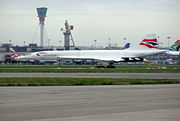
- In March 2002, thieves stole US $3 million that had arrived on a South African Airways flight.
- In February 2003, the British Army was deployed to Heathrow, with 1,000 extra police officers, due to intelligence reports that al-Qaeda terrorists might launch surface-to-air missile attacks at British or American airliners.
- Scotland Yard's Flying Squad foiled an attempt by seven men to steal £40 million in gold bullion and a similar quantity of cash from the Swissport warehouse at Heathrow on 17 May 2004.
- On 10 August 2006, the airport became the focus of changes in security protocol following the revelation of a supposedly al-Qaeda based 2006 transatlantic aircraft plot. New rules were put in force immediately with lengthy delays and inconvenience to passengers. These included the prohibition of carry-on luggage (except essential items such as travel documents and medication) and all liquids - although this was later relaxed to allow medications, as well as baby milk - provided both were tasted first by the passenger at the security checkpoint.
- On 25 February 2008, Greenpeace activists protesting against the planned third runway managed to cross the tarmac and climb on top of a British Airways Airbus A320 which had just arrived from Manchester Airport. At about 09:45 GMT the protestors unveiled a banner over the aircraft's tailfin stating "Climate Emergency - No Third Runway" and by 11:00 GMT four arrests had been made.
- On March 13, 2008 a man with a rucksack scaled the perimeter fence onto runway 27R and ran across the grounds, resulting in his subsequent arrest. A controlled explosion of his bag took place, although nothing suspicious was found and the Metropolitan Police said that the incident was not terrorism related.
Heathrow today
Heathrow Airport is used by over 90 airlines which fly to 170 destinations worldwide. The airport is the primary hub of British Airways and Virgin Atlantic and a major hub for bmi.
Of Heathrow's 67 million annual passengers, 11% travel to UK destinations, 43% are short-haul international travellers, and 46% are long-haul. The busiest single destination in terms of passenger numbers is New York, with over 3.4 million passengers travelling between Heathrow and JFK / Newark airports in 2006. The airport has five passenger terminals (Terminals 1, 2, 3, 4 and 5) and a cargo terminal. Terminal 5 opened to passengers on 27 March 2008 and will be fully completed with the opening of its second satellite building in 2010.
Originally, Heathrow had six runways, arranged in three pairs at different angles, with the passenger terminal in the centre. With growth in the required length for runways, Heathrow now has just two parallel runways running east-west. Runway 23, a short runway for use in strong south-westerly winds, was decommissioned in 2005 and now forms part of a taxiway. The Department for Transport has issued a 'consultation document' in which one option is the construction of a third parallel east-west runway for frequent use, involving the demolition of residential areas.
In 2006, the new £105 million Pier 6 was completed at Heathrow's Terminal 3 in order to accommodate the Airbus A380 superjumbo, providing four new aircraft stands. Other modifications totalling in excess of £340 million have also been carried out across the airfield in readiness for the Airbus A380, and the newly opened Terminal 5 is also fully compatible with the A380. The first A380 test flight into Heathrow took place on 18 May 2006, but following delays to the aircraft's production, scheduled services did not commence from Heathrow until 18 March 2008, when Singapore Airlines flight SQ308 touched down from Singapore carrying 470 passengers, marking the first ever European commercial flight by the Airbus A380.
A new 87 metres (285 ft) high £50 million air traffic control tower entered service on 21 April 2007, and was officially opened on 13 June 2007 by Secretary of State for Transport Douglas Alexander.
Heathrow Airport has Anglican, Catholic, Free Church, Muslim, Sikh, Hindu and Jewish Chaplains. There is a multi-faith prayer room and counselling room in each terminal, in addition to St. George's Interdenominational Chapel which is located in an underground bunker adjacent to the old Control Tower, where Christian services take place. The chaplains organise and lead prayers at certain times in the prayer room. There is an Anglican Service every Tuesday and Wednesday, daily Catholic Mass and Free Church prayers in the Chapel.
Heathrow's facilities were designed to accommodate either 45 or 55 million passengers annually according to BAA (55 million the figure presented to the T5 Inquiry, 45 million the figure used for the consultation into the third runway). With numbers now approaching 70 million and runway utilisation averaging 98%, it is difficult for existing airlines to obtain landing slots to enable them to increase their services from the airport, or for new airlines to start operations. For the same reason the airport has become crowded and subject to delays, for which it has been criticised in recent years and in 2007 the airport was voted the world's least favourite alongside Chicago O'Hare in a TripAdvisor survey.
Operations
Aircraft destined for Heathrow usually enter its airspace via one of four main 'reporting points': Bovingdon (BNN) over Hertfordshire, Lambourne (LAM) over Essex, Biggin Hill (BIG) over Bromley and Ockham (OCK) over Surrey. Each is defined by a VOR radio-navigational beacon. When the airport is busy, aircraft will orbit in the associated holds. These reporting points/holds lie respectively to the north-west, north-east, south-east and south-west of the London conurbation.
Air traffic controllers at Heathrow Approach Control (based in Swanwick, Hampshire) then guide the aircraft to their final approach, merging aircraft from the four holds into a single stream of traffic, sometimes as close as 2.5 nautical miles (4.6 km) apart. Considerable use is made of continuous descent approach techniques to minimise the environmental effects of incoming aircraft, particularly at night. Once an aircraft is established on its final approach, control is handed over to Heathrow Tower.
Because aircraft generate significantly more noise on departure than when landing, there is a preference for "westerly operations" during daytime operations. In this mode aircraft depart towards the west and approach from the east over London, thereby minimising the noise impact to the most densely populated areas. Heathrow's two runways generally operate in 'segregated mode' whereby arriving aircraft are allocated to one runway and departing aircraft to the other. To further reduce noise nuisance to people beneath the approach and departure routes, the use of runways 27R and 27L is swapped at 3 pm each day, when the wind is from the west. When easterly landings are in progress there is no alternation; 09L remains the landing runway and 09R the departure runway due to the Cranford protocol. Occasionally landings are allowed on the nominated departure runway, to help reduce airborne delays and to position landing aircraft closer to their terminal, thus reducing taxi times.
Night-time flights at Heathrow are subject to restrictions. Between 11.00 p.m. and 7.00 a.m. the noisiest aircraft (rated QC/8 and QC/16) cannot be scheduled to operate at all. In addition, between 11.30 p.m. and 6.00 a.m. (the night quota period) there are three limits:
- A limit on the number of flights allowed;
- A Quota Count system which limits the total amount of noise permitted, but allows operators to choose to operate fewer noisy aircraft or a greater number of quieter planes;
- A voluntary ban on QC/4 aircraft.
Security
Policing of the airport is the responsibility of the aviation security unit of the Metropolitan Police, however the army, including armoured vehicles of the Household Cavalry, has occasionally been deployed to the airport during periods of heightened security. Heathrow's reputation for thefts has led to it sometimes being referred to as 'Thiefrow'.
Regulation
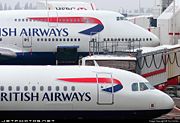
As BAA owns London's three major airports and therefore has a monopolistic position, the amount it is allowed to charge airlines to land aeroplanes at Heathrow is heavily regulated by the Civil Aviation Authority (CAA). Until 1 April 2003, the annual increase in landing charge per passenger was capped at inflation minus 3%. From 2003 to 2007, charges increased by inflation plus 6.5% per year, taking the fee to £9.28 per passenger in 2007. In March 2008, the CAA announced that the charge would be allowed to increase by 23.5% to £12.80 from 1 April 2008, and by inflation plus 7.5% for each of the following four years.

In addition, air traffic between Heathrow and the United States is strictly governed by the countries' bilateral Bermuda II treaty. The treaty originally allowed only British Airways, Pan Am, and TWA to fly from Heathrow to the US. In 1991 PAA and TWA sold their rights to United Airlines and American Airlines respectively, and Virgin Atlantic Airways was added to the list of airlines allowed to operate on these routes. In 2002, American Airlines and British Airways announced plans to coordinate the scheduling of their trans-Atlantic routes but plans were dropped after the United States Department of Transportation made approval conditional on the granting of further access slots to Heathrow to other US airlines. American Airlines and British Airways considered the slots too valuable and dropped the plans. The Bermuda bilateral agreement conflicts with the Right of Establishment of the United Kingdom in terms of its membership in the EU, and as a consequence the UK was ordered to drop the agreement in 2004. A new " open skies" agreement was signed by the United States and the European Union on 30 April 2007, and will come into effect on 30 March 2008.
Whilst the cost of landing at Heathrow is determined by the CAA and BAA, the allocation of landing slots to airlines is carried out by Airport Co-ordination Limited (ACL).
Busiest airport claims

The operator of Heathrow, BAA, claims that Heathrow is the "world's busiest international airport", but Heathrow is only the world's third-busiest airport by total passenger traffic, after Atlanta-Hartsfield-Jackson and Chicago O'Hare, which are also international airports. However, Heathrow has the highest number of international passengers.
In 2006 Heathrow was the busiest airport in Europe in terms of total passenger traffic (18.8% more passengers than at Paris Charles de Gaulle Airport and 27.9% more than at Frankfurt International Airport), but it was third behind Charles de Gaulle and Frankfurt in terms of plane movements (11.9% fewer landings and take offs than at Charles de Gaulle, and 2.5% fewer than at Frankfurt). Heathrow airport was fourth in terms of cargo traffic (36.9% less cargo than at Charles de Gaulle, 36.8% less than at Frankfurt, and 14.2% less than at Amsterdam Schiphol Airport).
With only two runways operating at over 98% of their capacity, Heathrow has little room for growth. In order to increase traffic, BAA has proposed using the existing two runways in 'mixed mode' whereby aircraft would be allowed to take-off and land on the same runway. This would increase the airport's capacity from its current 480,000 movements per year to as many as 550,000 according to British Airways CEO Willie Walsh. BAA has also proposed to build a third runway to the north of the airport, which would significantly increase traffic capacity (see Third Runway and Terminal 6 below).
In the short term the opening of Terminal 5 in 2008 will relieve pressure on terminal facilities, allowing modest growth from the use of larger aircraft such as the Airbus A380. However with passenger traffic at Charles de Gaulle growing by 5.8% to 59.3 million during the 12 months to September 2007, compared with Heathrow's fall of 0.4% to 67.6 million during the same period, it may be likely that CDG ---- with its four runways operating at only 73.5% capacity ---- could overtake Heathrow by 2010.
Terminals
Terminal 1
Terminal 1 was opened in 1968 and was formally opened by Queen Elizabeth II in May 1969. In 2005, a substantial redesign and redevelopment of Terminal 1 was completed, which saw the opening of the new Eastern Extension, doubling the departure lounge in size and creating additional seating and retail space.
Terminal 2
Terminal 2 is Heathrow's oldest terminal and was opened as the Europa Building in 1955. Terminal 2, as well as the adjacent Queens Building, will close in 2008 after the opening of Terminal 5, to allow for the construction of the new Heathrow East terminal.
Terminal 3
Terminal 3 was opened as The Oceanic Terminal on 13 November 1961 to handle flight departures for long-haul routes. At this time the airport had a direct helicopter service from Central London from the gardens on the roof of the terminal building. The Oceanic Terminal was renamed as Terminal 3 in 1968 and was expanded in 1970 with the addition of an arrivals building. Other facilities were also added, including the UK's first moving walkways. In 2006, the new £105 million Pier 6 was completed in order to accommodate the Airbus A380 superjumbo; Singapore Airlines now operate regular flights from Terminal 3 using the Airbus A380.
Redevelopment of Terminal 3's forecourt by the addition of a new four lane drop-off area and a large pedestrianised plaza, complete with canopy to the front of the terminal building was completed in 2007; these improvements were intended to improve passengers' experiences, reduce traffic congestion and improve security. BAA also have plans for a £1bn upgrade of the rest of the terminal over the next ten years.
Terminal 4
Terminal 4 was constructed to the south of the southern runway next to the existing cargo terminal, away from the three older terminals, and was connected with Terminals 1, 2 and 3 by the already-existing Heathrow Cargo Tunnel. Terminal 4 was opened by the Prince and Princess of Wales in April 1986, and became the home for then newly- privatised British Airways.
Terminal 4 will also benefit from a major upgrade to its existing facilities once Terminal 5 has opened. BAA have stated that the building is in need of extensive refurbishment. As part of the redevelopment of Terminal 4, the amount of natural light entering the building will be assessed and the check-in facilities and airside departure lounge will also be upgraded.
Terminal 5
The possibility of a fifth terminal at Heathrow emerged as early as 1982, when there was debate over whether the expansion of Stansted or the expansion of Heathrow (advocated by BA) was the way forward for the UK aviation industry. Richard Rogers was selected to design the terminal in 1989 and BAA formally announced its proposal for T5 in May 1992, submitting a formal planning application on 17 February 1993. A public inquiry into the proposals began on 16 May 1995 and lasted nearly four years, finally ending after 525 days on 17 March 1999. Finally on 20 November 2001, more than eight years after the initial planning application, then-transport minister Stephen Byers announced the British government's decision to grant planning permission for the building of a fifth passenger terminal at Heathrow.
The new terminal was built on the western side of the airport on the site of the former Perry Oaks sewage works, between the northern and southern runways. The four storeys of the main terminal building (Concourse A) are covered by a single-span undulating steel frame roof, stretching 90 metres (295 ft) from east to west. Departing passengers will enter the departures level on the 3rd floor after taking one of the lifts or escalators from the interchange plaza. Upon entering the departures concourse, passengers will see views across Heathrow and the surrounding area, and be in a space that is unobstructed to the rising roof above. After check-in and security screening, the airside departure lounge will also provide views across the airport, its runways and beyond. There will be an abundance of retail and catering outlets and many other facilities.
In addition to the main terminal building, Terminal 5 also has two satellite buildings, linked to the main terminal by an underground people mover transit system. The first satellite (Concourse B) includes dedicated aircraft stands for the Airbus A380; Concourse C is currently under construction and scheduled to open in 2010. In total, Terminal 5 will have 60 aircraft stands, and be connected to Terminals 1, 2 and 3 by the Heathrow Airside Road Tunnel.
Terminal 5's total cost is £4.3 billion. It will cater for 30 million passengers annually and will enable Heathrow to handle up to 90 million passengers a year, up from its current figure of 68 million (compared with a design capacity of 45 million). In 2005, Terminal 5 was the largest construction project in Europe - over 80,000 people will have worked on the project, with expenditure peaking at £12 million per week.
The transport network around the airport has been extended to cope with the increase in passenger numbers. A dedicated motorway spur has been built from the M25 between junctions 14 and 15 to the terminal, which includes a 4,000 space multi-storey car park. A more distant long-stay car park for business passengers will be linked to the terminal by a personal rapid transit system, which will open in 2009. New branches of both the Heathrow Express and the Underground's Piccadilly Line will serve a new shared Heathrow Terminal 5 station, which will also have space for a third pair of tracks for future additional rail services. BAA are currently consulting on the route of a new rail link, called AirTrack, to Staines and through direct services to Reading, Guildford and London Waterloo.
Queen Elizabeth II officially opened Terminal 5 in a ceremony on 14 March 2008. The first flights to and from Terminal 5 occured on 27 March 2008. The first flight to use the terminal was British Airways flight 26 from Hong Kong. Flight 302 to Paris was the first flight departure from Terminal 5 at 06:20 GMT.
Heathrow East Terminal
BAA announced in November 2005 that when Terminal 5 opens Terminal 2 will be closed to allow the Heathrow East scheme to be built. This will see Terminal 2 and the Queen's Building offices being replaced by a new terminal capable of handling 30 million people, five million fewer than Terminals 1 and 2 are currently used by, although considerably more than the design capacity of the existing buildings. Work is planned to start in 2008 and to be completed by 2012, in time for the London Olympics, although reported delays are making this target unlikely. The plan envisages the complete realignment of piers more logically, and to provide for an increase in capacity, in a site taking up roughly the same amount of space as T5. The entire project is set to cost £1-1.5bn. Planning permission was granted in May 2007 on condition that the project meets a number of 'green' targets.
North Terminal
The current proposals for a third runway to the north of the current airport includes an additional terminal. Although currently referred to as "Terminal 6" by the time it could be built Terminals 1 and 2 would have been replaced by the East Terminal making it a possible fifth terminal overall.
Access
Public transport
- Heathrow Express: a non-stop service directly to London's Paddington station; trains leave every 15 minutes for the 15-minute journey. The Heathrow Express is also used for transferring people between the central area of Heathrow (Terminals 1, 2 and 3) and Terminal 4 which has its own station; use of this section is free of charge.
- Heathrow Connect service to Paddington calling at up to five National Rail stations en route; as of December 2006 trains leave every 30 minutes for the 25-minute journey. The Heathrow Connect train terminates at Heathrow Central for Terminals 1, 2 and 3, with free transfer via the Heathrow Express for Terminal 4.
- London Underground Piccadilly line with four stations - Terminals 1, 2 and 3; Terminal 4; Terminal 5 and Hatton Cross. As of 2007, the standard journey time from the Terminals 1-3 station to Central London is 40-50 minutes (for example, 48 minutes to Piccadilly Circus).
- For the above three services, the faster the journey, the more expensive it is.
- Long-distance coach services operated by National Express to various parts of the UK, including Victoria Coach Station in London.
- A door-to-door London hotel shuttle bus service is operated by dot2dot from each terminal, and HotelHoppa buses connect each terminal with hotels in the Heathrow area.
- There are four RailAir coach services connecting nearby railway stations with the airport using dedicated non-stop coaches. These run to:
- Reading railway station, connecting with railway services to the West Country, South Wales, Midlands and south coast of England
- Feltham railway station, for destinations on the South West Trains network in south-West London, Surrey and Berkshire, including Windsor (this has now been discontinued and replaced by the 285 bus service, as advertised on South West Trains)
- Woking railway station, for places in Surrey, Hampshire, Dorset and Wiltshire
- Watford Junction railway station, for Virgin Trains and London Midland services to Hertfordshire, Buckinghamshire, Bedfordshire, the Midlands, north-west England and Scotland
- Heathrow Airport has one of the United Kingdom's biggest bus stations, with many local bus services ( Transport for London) to nearby London suburbs.
Car
Heathrow is accessible via the nearby M4 motorway and A4 road (Terminals 1–3), the M25 motorway (Terminals 4 and 5), and the A30 road (Terminal 4). There are drop off and pick up areas at all terminals and short and long stay multi-storey car parks. Additionally, there are car parks (not run by BAA) just outside the airport, these are connected to the terminals by shuttle buses. Heathrow airport is also served by taxi services.
Four parallel tunnels under one of the runways connect the M4 motorway and the A4 road to Terminals 1–3. The two larger tunnels are each two lanes wide and are used for motorised traffic. The two smaller tunnels were originally reserved for pedestrians and bicycles; to increase traffic capacity the cycle lanes have been modified to each take a single lane of cars, although bicycles still have priority over cars. Pedestrian access to the smaller tunnels has been discontinued, with the free bus services being the alternative.
Bicycle
There are (mainly off-road) bicycle routes almost to the terminals. Free bicycle parking places are available in car parks 1 and 1A, though use of the left-luggage services may be more secure. Free specialist maps showing cycle routes are published by Transport for London - 'London Cycling Guide 6' covers Terminals 1, 2 & 3 while 'London Cycling Guide 9' covers Terminal 4 (as of the June 2007 revision).
One coach on each Heathrow Connect train has an area reserved for wheelchairs and bicycles (wheelchairs have priority). Heathrow Express trains have space for three bicycles. There are rush-hour restrictions: unfolded bicycles are not allowed on trains due to arrive at Paddington between 07:45 and 09:45, or departing between 16:30 and 18:30, Monday to Friday.
If luggage and conditions permit, it is very much cheaper (about one third the price) to travel by train between Paddington and Hayes & Harlington and then cycle the remaining two miles (3 km).
Future expansion
The major airlines at Heathrow, in particular British Airways, have long advocated construction of a new third runway at Heathrow. A sixth terminal would be likely to accompany the new runway, and the airport's capacity would be increased to 115 million passengers per year. On 16 December 2003 Transport Secretary Alistair Darling released a white paper on the future of air transport in the UK. A key proposal of the paper was that a new 2000 metre runway suitable for use only by short-haul aircraft would be built at Heathrow by 2020 provided that targets on environmental issues such as aircraft noise, traffic congestion and pollution could be met.
In December 2006 the DFT published a progress report on the strategy which confirmed the original vision, and in November 2007 the government started a public consulation on proposals for a longer 2,500 metres (2,734 yd) third runway. However proposed flight paths show integration from runway 3 into longhaul west bound routings suggesting that the desired length will eventually be similar to that of the existing runways. The consultation process includes proposals to remove the existing runway alternation for landings, and also to allow departures from both runways over London (previously banned under the Cranford Agreement) when wind direction requires. If approved, the new runway would open around 2020.
Opposition
The continued expansion of Heathrow Airport is opposed by environmental campaigners who are concerned about increases of CO2 emissions, by Londoners concerned about noise and local residents concerned about their communities.
Locally some 700 homes, a church and eight grade II listed buildings would have to be demolished or abandoned, the high street in Harmondsworth split, a graveyard "bulldozed" and the "entire village of Sipson could disappear". John McDonnell, MP for Hayes and Harlington has suggested that up to 4,000 houses would actually have to be demolished or abandoned, however aviation minister Jim Fitzpatrick defended the plans, saying anyone evicted from their home as a result of expansion would be fully compensated and BAA have committed to preserving the Grade I listed church and tithe barn at Harmondsworth, and have assured protection of the value of properties blighted by a possible third runway.
The government has been criticised for working too closely with BAA in designing tests to determine whether noise and air pollution caused by the proposed runway would exceed designated limits. However the Department for Transport defended the co-operation, stating that "it wouldn’t be sensible or indeed possible to do the work without the expertise of the airport operator."
The World Development Movement has claimed that the proposed additional flights from Heathrow’s third runway would emit same amount of CO2 per year as the whole of Kenya. Ruth Kelly, Transport Secretary, has stated that carbon emissions will not actually rise overall in the environment since carbon trading will be used to ensure that these increases from Heathrow are offset by reductions elsewhere in the economy. However Friends of the Earth claim that "Plans to bring aviation into the EU Emissions Trading Scheme (ETS) will barely affect the rapid growth in aviation’s carbon emissions".
A protest camp, the Camp for Climate Action, took place close to the airport in August 2007 and attracted some 2000 protesters, along with considerable media attention. Prior to the camp's start, BAA had attempted to get court approval for an injunction to limit their right to protest which became known as the "Mother of all Injunctions". BAA said the injunction was intended to protect the security of staff and passengers and that "flights and passengers were unaffected by the camp".
In response to campaigning and proposed new legislation that would restrict aviation growth, BAA and others launched Flying Matters "to represent the travel industry over climate change".
Since the 1970s, there have been proposals to replace Heathrow by a new airport located in the Thames Estuary. Proponents of these schemes argue that flights would no longer arrive or depart over densely populated areas of London, and costs are estimated at two billion pounds, less than the construction of a third runway at Heathrow. However, surface access to London and the South-East of England would be more difficult than at Heathrow, and the area proposed is in the path of migratory bird routes which could cause safety concerns for aircraft, as well as the destruction of natural habitats.
Airlines and destinations
Locations valud until end of April 2008
Terminal 1
- Aer Lingus (Belfast-International, Cork, Dublin)
- Asiana Airlines (Seoul-Incheon)
- bmi (Aberdeen, Addis Ababa, Aleppo, Almaty, Amman, Amsterdam, Ankara, Baku, Beirut, Belfast-City, Bishkek, Brussels, Cairo, Dakar, Damascus, Dammam, Dublin, Durham Tees Valley, Edinburgh, Ekaterinburg, Freetown, Glasgow-International, Hanover, Jeddah, Jersey, Khartoum, Leeds-Bradford, Lyon, Manchester, Moscow-Domodedovo, Naples [seasonal], Nice [ends 1 May], Palma de Mallorca, Riyadh, Tbilisi, Tehran-Imam Khomeini, Tel Aviv, Venice, Yerevan)
- British Airways (Barcelona, Helsinki, Lisbon, Madrid)
- Cyprus Airways (Larnaca, Paphos)
- El Al Israel Airlines (Ovda [seasonal], Tel Aviv)
- Finnair (Helsinki)
- Icelandair (Reykjavik-Keflavik)
- LOT Polish Airlines (Warsaw)
- South African Airways (Cape Town, Johannesburg)
- Transaero (Moscow-Domodedovo)
- US Airways (Philadelphia)
Terminal 2
- Aeroflot (Moscow-Sheremetyevo)
- Air Algérie (Algiers)
- Air Astana (Almaty)
- Air France (Los Angeles [begins 31 March], Paris-Charles de Gaulle)
- Air Seychelles (Seychelles)
- Air Transat (Toronto-Pearson)
- Alitalia (Milan-Linate, Milan-Malpensa [ends 30 March], Rome-Fiumicino)
- Alitalia Express (Milan-Linate)
- Austrian Airlines (Vienna)
- Tyrolean (Vienna)
- Azerbaijan Airlines (Baku)
- Bellview Airlines (Lagos)
- Bestair (Antalya)
- China Eastern Airlines (Shanghai-Pudong)
- Clickair (La Coruña, Valencia)
- Croatia Airlines (Rijeka, Split, Zagreb)
- Czech Airlines (Prague)
- Bulgaria Air (Sofia)
- operated by Hemus Air (Sofia)
- Iberia Airlines (Barcelona, Bilbao, Madrid)
- Iran Air (Tehran-Imam Khomeini)
- Jat Airways (Belgrade)
- Libyan Airlines (Tripoli)
- Lufthansa (Cologne/Bonn, Düsseldorf, Frankfurt, Hamburg, Munich, Stuttgart)
- Luxair (Luxembourg)
- Nouvelair (Monastir)
- Olympic Airlines (Athens)
- Rossiya (St. Petersburg, Moscow-Vnukovo)
- Royal Air Maroc (Casablanca, Marrakesh, Tangier)
- Atlas Blue (Tangier [starts April, 2008]
- Sudan Airways (Khartoum)
- Swiss International Air Lines (Zürich, Geneva)
- Syrian Arab Airlines (Damascus)
- TAP Portugal (Faro, Funchal, Lisbon, Porto)
- TAROM (Bucharest-Otopeni)
- Tunisair (Tunis)
- Uzbekistan Airways (Tashkent)
- Yemenia (Sana'a)
Terminal 3
- Air Canada (Calgary, Edmonton, Halifax, Montréal, Ottawa, Toronto-Pearson, Vancouver)
- Air China (Beijing, Shanghai-Pudong)
- Air India (Ahmedabad [seasonal], Amritsar [seasonal], Hyderabad, Chennai, Chicago-O'Hare, Delhi, Kolkata, Dhaka, Mumbai, New York-JFK)
- Air Mauritius (Port Louis)
- Air New Zealand (Auckland, Hong Kong, Los Angeles)
- All Nippon Airways (Tokyo-Narita)
- American Airlines (Boston, Chicago-O'Hare, Dallas/Fort Worth [begins 30 March], Los Angeles, Miami, New York-JFK, Raleigh/Durham [begins 30 March])
- Biman Bangladesh Airlines (Dhaka, Dubai)
- Blue1 (Helsinki) [begins 30 March]
- Cathay Pacific (Hong Kong)
- Cyprus Turkish Airlines (Izmir, Lefkosa)
- EgyptAir (Cairo, Luxor)
- Emirates (Dubai)
- Ethiopian Airlines (Addis Ababa, Rome-Fiumicino)
- Etihad Airways (Abu Dhabi)
- EVA Air (Bangkok-Suvarnabhumi, Taipei-Taiwan Taoyuan)
- Gulf Air (Bahrain)
- Japan Airlines (Osaka-Kansai, Tokyo-Narita)
- Jet Airways (Amritsar, Delhi, Mumbai)
- Korean Air (Seoul-Incheon)
- Kuwait Airways (Kuwait, New York-JFK)
- Malaysia Airlines (Kuala Lumpur)
- Middle East Airlines (Beirut)
- Pakistan International Airlines (Islamabad, Karachi, Lahore, Peshawar)
- Qatar Airways (Doha)
- Royal Brunei Airlines (Bandar Seri Begawan, Dubai)
- Royal Jordanian (Amman)
- Saudi Arabian Airlines (Dammam, Jeddah, Madinah [seasonal], Riyadh)
- Scandinavian Airlines (Copenhagen, Gothenburg-Landvetter, Oslo, Stavanger, Stockholm-Arlanda)
- Singapore Airlines (Singapore)
- Thai Airways International (Bangkok-Suvarnabhumi)
- Turkish Airlines (Antalya, Istanbul-Atatürk, Izmir)
- Turkmenistan Airlines (Ashgabat)
- United Airlines (Chicago-O'Hare, Denver [begins 30 March], Los Angeles, San Francisco, Washington-Dulles)
- Virgin Atlantic Airways (Boston, Cape Town, Chicago-O'Hare, Delhi, Dubai, Hong Kong, Johannesburg, Lagos, Los Angeles, Miami, Mumbai, Nairobi, New York-JFK, Newark, Port Louis, San Francisco, Shanghai-Pudong, Sydney, Tokyo-Narita, Washington-Dulles)
Terminal 4
- Air Malta (Luqa)
- British Airways (Abu Dhabi, Abuja, Accra, Algiers [begins 30 March], Bahrain, Baltimore/Washington, Bangalore, Bangkok-Suvarnabhumi, Basel/Mulhouse, Beijing, Belgrade, Boston, Buenos Aires-Ezeiza, Cairo, Calgary, Cape Town, Chennai, Chicago-O'Hare, Dallas/Fort Worth [begins 30 March], Dar es Salaam, Delhi, Denver, Detroit, Dhaka, Doha, Dubai, Entebbe, Grand Cayman, Houston-Intercontinental, Hyderabad [begins 27 October], Islamabad, Kolkata, Kuwait, Lagos, Luanda, Lusaka, Mexico City, Montréal, Mumbai, Muscat, Nairobi, Nassau, New York-JFK, Newark, Philadelphia, Phoenix, Port Louis, Providenciales, Rio de Janeiro-Galeão, São Paulo-Guarulhos, Seattle/Tacoma, Shanghai-Pudong, Singapore, Sydney, Tel Aviv, Toronto-Pearson, Vienna, Washington-Dulles, Zürich)
- China Southern Airlines (Beijing) [begins March, 2009]
- Continental Airlines (Houston-Intercontinental, Newark)
- Delta Air Lines (Atlanta, New York-JFK)
- Kenya Airways (Nairobi)
- KLM Royal Dutch Airlines (Amsterdam)
- KLM Cityhopper (Rotterdam)
- Northwest Airlines (Detroit [begins 2 May], Minneapolis/St. Paul [begins 30 March], Seattle/Tacoma [begins 2 June])
- Qantas (Bangkok-Suvarnabhumi, Hong Kong, Melbourne, Singapore, Sydney)
- Sri Lankan Airlines (Colombo, Malé)
- TAM Airlines (São Paulo-Guarulhos, Salvador da Bahia [seasonal])
Terminal 5
- British Airways (Aberdeen, Amsterdam, Athens, Berlin-Tegel, Brussels, Bucharest-Otopeni, Budapest, Copenhagen, Düsseldorf, Edinburgh, Frankfurt, Geneva, Glasgow-International, Hamburg, Hong Kong, Istanbul-Atatürk, Johannesburg, Kiev-Boryspil, Larnaca, Los Angeles, Lyon, Malaga [begins 30 March], Manchester, Miami, Milan-Linate, Milan-Malpensa, Moscow-Domodedovo, Munich, Newcastle, Oslo, Paris-Charles de Gaulle, Prague, Rome-Fiumicino, St. Petersburg, San Francisco, Sofia, Stockholm-Arlanda, Stuttgart, Tripoli, Tokyo-Narita, Vancouver)
Terminal rearrangements
When Terminal 5 opens in 2008, the allocation of airlines to terminals at Heathrow will undergo major changes. The new arrangements will largely be based around which alliance each airline belongs to. The transfer will be completed over a period of 10 months starting from March 2008.
- Complete.' At the end of March 2008, the majority of British Airways shorthaul flights moved from T1 and T4 and all longhaul flights from T1 and T3, into T5. Routes operating Boeing 757 aircraft remain in T1 until the refurbishment of T3 is complete.
- Star Alliance members will then move into T1.
- All other members of the Oneworld alliance, plus Aer Lingus will join Virgin Atlantic in T3.
- At the end of April 2008, British Airways' remaining T4 services will move to T5. This excludes flights to Bangkok, Singapore, Sydney, Madrid, Barcelona, Helsinki, Lisbon, Nice and Algiers, which will operate from T3.
- All SkyTeam alliance members as well as most non-aligned airlines will move to Terminal 4.
- Finally, when T5's second satellite pier (T5C) is completed in 2010, all British Airways flights will operate from T5.
As such, by 2010, the airline arrangements at Heathrow will be as follows:
- Terminal 1 (and subsequently Heathrow East) - Star Alliance
- Terminal 3 - Oneworld alliance (except British Airways), Aer Lingus, and Virgin Atlantic
- Terminal 4 - SkyTeam alliance and most non-aligned airlines
- Terminal 5 - British Airways
